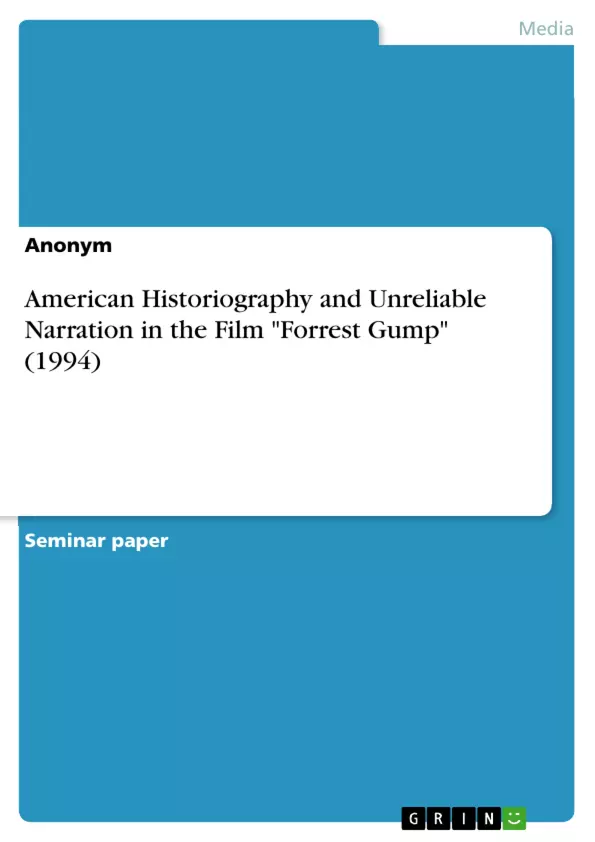This paper focuses on the American history of the last century and its historiography. I will first investigate the theoretical background of historiography and then connect it with the concept of unreliable narration. I will then answer the question of whether historiography and unreliable narration correlate or influence each other while examining what the events of the past have demonstrated so far in this regard. In the practical section, I will establish a story and discourse analysis by focusing on the historiography presented in the movie Forrest Gump. I will choose particular scenes and compare them with America’s real historical events. After this, I will concentrate on the concept of unreliability in the movie. The central question is whether Forrest Gump is an unreliable narrator and why the audience might see him as such. The film’s framing, use of narrative techniques and cinematography are central as well and might contribute to answering this question. I will describe how the scenes are produced and to what extend this production influences the spectator. In a final step, I will summarise the results and place them in a sociocultural context.
"My momma always said, life was like a box of chocolates; you never know what you’re gonna get. (Forrest Gump 1994: 00:03:37-00:03:46)"
This famous sentence, articulated by Forrest Gump’s mother, sets the theme for the entire movie. While watching the film, the audience never knows what comes next in Forrest’s life, such as what he will achieve or who he will meet. The film is an ongoing surprise for the spectator.
The film Forrest Gump is a 1994 American comedy-drama directed by Robert Zemeckis and written by Eric Roth. The story is based on the 1986 novel by Winston Groom and stars, amongst others, Tom Hanks, Robin Wright and Gary Sinise. The good-natured Forrest Gump, who is slightly handicapped and has an IQ of only 75, lives through the second half of the 20th century and experiences first-hand many major moments in American history. He is accompanied by his great love from his youth, Jenny, whom he always loses sight of because their lives develop separately from each other. However, they finally find each other and get married, and Jenny gives birth to their son, who is also called Forrest.
Table of Contents
- Introduction
- Theoretical Part: Historiography and Unreliable Narration
- What Is Historiography?
- What Is Unreliable Narration?
- How Do Historiography and Unreliable Narration Correlate?
- Practical Part: Story and Discourse Analysis
- American History Presented in Forrest Gump (1994)
- Unreliable Narration in Forrest Gump and the Use of Narrative Techniques
- Conclusion
Objectives and Key Themes
This paper aims to analyze the portrayal of American history in the film Forrest Gump (1994) through the lens of historiography and unreliable narration. It will explore the theoretical frameworks of both concepts, investigate their potential correlation, and examine how they intersect within the film's narrative.
- Historiography and its evolution as a storytelling medium.
- The concept of unreliable narration in film and its impact on storytelling.
- The relationship between historiography and unreliable narration in the context of film.
- The specific portrayal of American history in Forrest Gump.
- The role of narrative techniques and cinematography in creating unreliable narration.
Chapter Summaries
- Introduction: The introduction sets the stage for the paper by introducing the film Forrest Gump and its central theme of life's unpredictability. It provides background information on the film and its narrative framework.
- Theoretical Part: Historiography and Unreliable Narration: This chapter defines the concepts of historiography and unreliable narration. It explores the distinction between history and historiography, highlighting the process of historical storytelling and its linguistic mediation. The chapter also delves into the concept of unreliable narration and its impact on storytelling, providing a theoretical foundation for the analysis.
- Practical Part: Story and Discourse Analysis: This chapter focuses on the film Forrest Gump and its portrayal of American history. It analyzes specific scenes and compares them with real historical events, exploring the film's historiographical approach. The chapter also examines the concept of unreliable narration within the film, analyzing Forrest Gump's potential unreliability as a narrator and the role of narrative techniques and cinematography in creating this effect.
Keywords
The paper centers around the intersection of historiography and unreliable narration in the film Forrest Gump. It explores key concepts such as historical storytelling, narrative techniques, cinematic portrayal of history, and the role of the unreliable narrator in shaping the narrative. These concepts are explored in the context of American history, focusing on specific historical events depicted in the film.
- Arbeit zitieren
- Anonym (Autor:in), 2019, American Historiography and Unreliable Narration in the Film "Forrest Gump" (1994), München, GRIN Verlag, https://www.hausarbeiten.de/document/1338658


